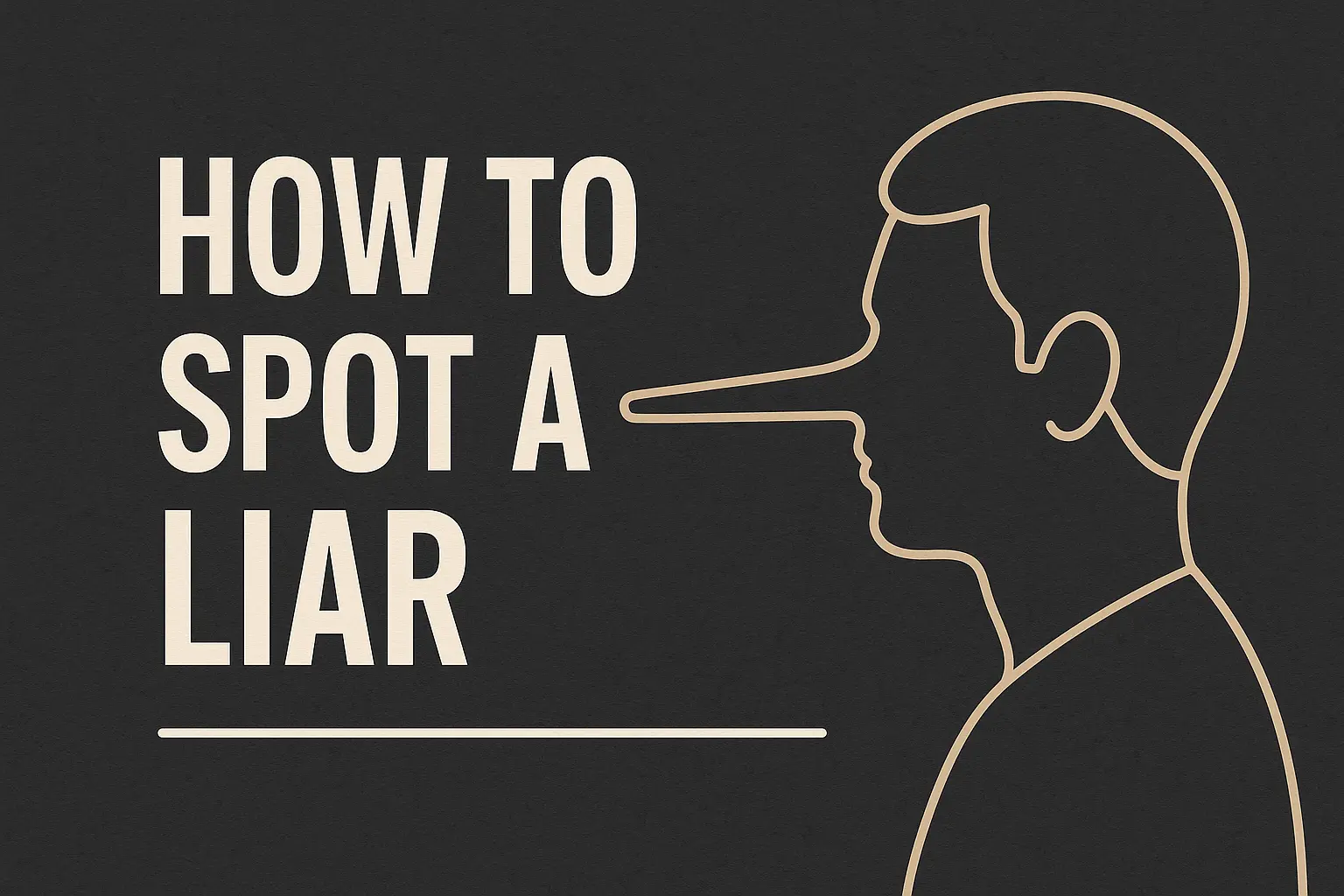While everyone tells the occasional white lie, some lies can seriously impact trust, finances, and emotional well-being.
Fortunately, behavioral science and psychology offer proven ways to detect deception—if you know what to look for.
This guide breaks down the most common signs of lying, subtle red flags, and expert-backed strategies to help you decode the truth in everyday interactions.
🔍 Why People Lie
Before diving into the signs, it’s important to understand the why behind lying. People lie for many reasons, including:
- To avoid punishment or consequences
- To gain a personal or professional advantage
- To protect someone’s feelings
- To maintain privacy
- Out of habit or compulsion (pathological lying)
According to a study published in Human Communication Research, people tell one to two lies per day on average. Most are harmless, but some can be dangerous.
🧠 The Psychology Behind Lying
Lying activates the brain’s prefrontal cortex, where decision-making and self-control live. Because lying takes more effort than telling the truth, liars often show signs of cognitive load—especially when lying on the spot.
Key Insight: Lying increases stress and brain activity, which can leak out as body language cues, voice changes, and inconsistencies.
🚩 10 Reliable Signs Someone Might Be Lying
1. Inconsistencies in Their Story
A truthful person can usually recount an event with consistent detail, even if you ask multiple times. A liar’s story may change or become vague.
🧠 Expert Tip: Ask follow-up questions. If details shift or timelines get fuzzy, you may be looking at deception.
2. Avoiding Eye Contact (or Overcompensating)
Contrary to myth, not all liars avoid your gaze—some stare too intensely to “prove” honesty.
✔️ What to Watch For:
- Too little or too much eye contact
- Blinking rapidly or darting eyes
- Looking to the right (associated with imagination)
3. Speech Hesitations and Fillers
Liars may pause longer before answering, overuse filler words (“uh,” “um,” “you know”), or repeat phrases.
🎙️ Example:
“I—uh—I didn’t take the keys. I swear. Like, seriously, I really didn’t. I mean… I swear.”
4. Too Many Details
In trying to seem believable, liars often add excessive (and unnecessary) detail.
🚩 Example:
“I was at the store on 5th Street at exactly 4:12 p.m. I bought a red apple and a bottle of water, then walked out at 4:28 p.m. I have the receipt!”
5. Body Language Doesn’t Match Words
A person’s body often reveals what their mouth tries to hide.
👀 Look For:
- Nodding “yes” while saying “no” (or vice versa)
- Shrugging while claiming certainty
- Covering the mouth, face, or neck
🧠 Source: FBI behavioral expert Joe Navarro notes these “comfort gestures” often indicate deception.
6. Changes in Voice Tone or Speed
The pitch of someone’s voice may rise when they lie, or they might speed up (or slow down) unnaturally.
🎧 What to Notice:
- Sudden changes in vocal rhythm
- Tightness in the throat
- Unusual pauses or breathing
7. Over-Defensiveness or Aggression
When challenged, liars may react strongly—getting angry, changing the subject, or accusing you of mistrust.
🛡️ Warning Signs:
- “Why would you even ask me that?!”
- “I can’t believe you’d think I’d do something like that!”
8. Physical Tells (Microexpressions & Nervous Gestures)
Microexpressions are involuntary facial expressions that last less than a second. Even skilled liars can’t always control them.
👁️ Common Signs:
- Brief flashes of fear, disgust, or guilt
- Fidgeting, scratching, or tapping fingers
- Shifting weight from foot to foot
📚 Backed by Research: Dr. Paul Ekman, who pioneered microexpression analysis, found that emotions can leak through even the most rehearsed lies.
9. They Distance Themselves from the Lie
Liars may avoid using first-person pronouns to detach themselves emotionally from the statement.
💬 Example:
“No one saw anything happen” instead of “I didn’t see anything happen.”
10. Gut Instinct
Don’t underestimate your intuition. Your brain picks up subtle cues even if you’re not consciously aware of them.
🧠 Backed by Science: A study in Psychological Science suggests that people can detect lies with higher accuracy when relying on gut feelings rather than overthinking.
✅ What To Do When You Suspect a Lie
- Stay calm. Avoid reacting emotionally, as this may escalate the situation.
- Ask open-ended questions. See how their story develops over time.
- Document details. Especially in serious scenarios (like fraud or betrayal).
- Look for patterns. One odd moment isn’t enough—but repeated signs often are.
- Trust—but verify. Be fair, but don’t ignore warning signs.
⚠️ A Note of Caution
While these signs can be helpful, none of them guarantee someone is lying. Cultural differences, social anxiety, and personal habits can mimic deception. Always consider the context.
🧠 Remember: Use these cues as indicators, not absolute proof.
🛠️ Tools and Techniques for Lie Detection
🔎 The Baseline Technique
Get to know how someone behaves when they’re relaxed and honest. This “baseline” lets you spot deviations when pressure hits.
🎭 The “Cognitive Load” Strategy
Lying is mentally taxing. Ask unexpected questions or have them recount the story backward—liars struggle with this more than honest people.
📖 Statement Analysis
Written lies leave clues too. Look for:
- Overly formal language
- Passive voice (“The vase was broken” vs. “I broke the vase”)
- Gaps in time or unnecessary clarifications
👥 When It Really Matters: Spotting Dangerous Liars
In some situations—like dating, hiring, or investing—spotting a manipulative liar can prevent serious harm. Look out for:
- Charm used as a distraction
- Flattery that feels over-the-top
- Refusal to be transparent
- Gaslighting (manipulating your perception of reality)
If you suspect deeper deceit or manipulation, it may help to consult a therapist, lawyer, or security professional.
🧾 Sources & Further Reading
- Ekman, Paul. Telling Lies: Clues to Deceit in the Marketplace, Politics, and Marriage
- Navarro, Joe. What Every BODY Is Saying
- Vrij, Aldert. Detecting Lies and Deceit: The Psychology of Lying and the Implications for Professional Practice
- Psychological Science, Human Communication Research
- FBI.gov Behavioral Analysis resources
Final Thoughts
Spotting a liar isn’t about playing detective 24/7—it’s about becoming more attuned to human behavior.
With awareness, a bit of training, and trust in your instincts, you can protect yourself, build healthier relationships, and make wiser decisions.
🧠 Key Takeaway: The more you understand human behavior, the easier it becomes to spot deception without jumping to conclusions.
Tasos Moulios is the founder of Beardlong. He loves trying different beard and hair styles and blogs about them. The tips he shares come from his own experience and love for what he does.

